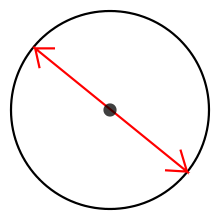diameter
English

Diameter shown as a red line
Etymology
From Old French diametre (French diamètre), from Latin diametrus, from Ancient Greek διάμετρος (diámetros) (γραμμή (grammḗ)) (diametros grammē, “line measuring across”), from διά (diá, “across”) + μέτρον (métron, “measure”).
Pronunciation
Noun
diameter (plural diameters)
- (geometry) Any straight line between two points on the circumference of a circle that passes through the centre/center of the circle.
- (geometry) The length of such a line.
- (geometry) The maximum distance between any two points in a metric space
- (graph theory) The maximum eccentricity over all vertices in a graph.
Related terms
Translations
line
|
|
length of this line
|
|
See also
Danish
Dutch
Pronunciation
Audio (file) - Hyphenation: di‧a‧me‧ter
Norwegian Bokmål
Noun
diameter m (definite singular diameteren, indefinite plural diametere or diametre or diametrer, definite plural diameterne or diametrene)
- a diameter
Norwegian Nynorsk
Noun
diameter m (definite singular diameteren, indefinite plural diameterar or diametrar, definite plural diameterane or diametrane)
- a diameter
Swedish
Declension
| Declension of diameter | ||||
|---|---|---|---|---|
| Singular | Plural | |||
| Indefinite | Definite | Indefinite | Definite | |
| Nominative | diameter | diametern | diametrar | diametrarna |
| Genitive | diameters | diameterns | diametrars | diametrarnas |
This article is issued from
Wiktionary.
The text is licensed under Creative
Commons - Attribution - Sharealike.
Additional terms may apply for the media files.